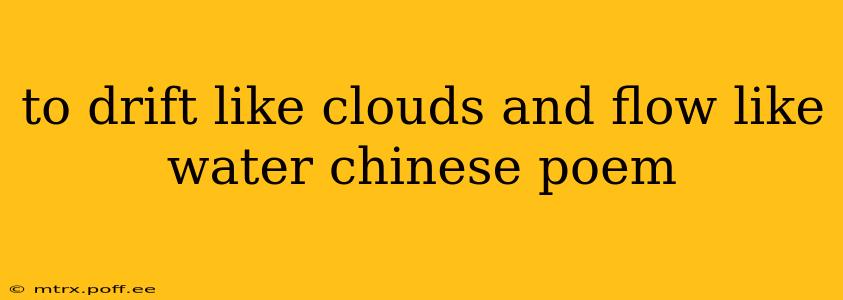To Drift Like Clouds and Flow Like Water: Exploring the Chinese Poetic Ideal
The evocative phrase "to drift like clouds and flow like water" encapsulates a powerful ideal within Chinese philosophy and poetry, representing adaptability, resilience, and effortless yielding in the face of life's challenges. This imagery, often found woven into classical poetry and philosophical texts, speaks to a profound understanding of natural harmony and the wisdom of navigating life's currents with grace. Let's delve deeper into this compelling metaphor.
What does "drifting like clouds" symbolize?
"Drifting like clouds" evokes a sense of freedom and unburdened movement. Clouds are not tethered to the earth; they move freely with the wind, changing shape and form effortlessly. This symbolizes a release from rigid adherence to plans or expectations. It suggests an acceptance of impermanence and the ability to adapt to changing circumstances. Just as clouds transform constantly, so too should one embrace change as a natural part of life, adapting and evolving with the flow.
What does "flowing like water" symbolize?
"Flowing like water" represents adaptability and resilience. Water is remarkably adaptable; it carves its path around obstacles, finds its level, and ultimately finds its way to the sea. This imagery speaks to a capacity to navigate life's challenges with flexibility and persistence. It emphasizes the importance of yielding gracefully to overcome obstacles rather than confronting them head-on with brute force. Water, while seemingly yielding, is also powerful in its consistency and unstoppable nature.
Where did this imagery originate?
While there isn't one single definitive source for this exact phrasing, the imagery of clouds and water as symbols of adaptability and yielding has deep roots in Taoist philosophy. The Tao Te Ching, a foundational text of Taoism, frequently uses natural imagery to illustrate the principles of yielding, flowing with the Tao (the natural order), and adapting to change. Many poems and writings across Chinese literature echo these themes, employing similar metaphors to express similar ideas about navigating life’s complexities.
How is this ideal reflected in Chinese poetry?
Countless Chinese poems utilize the imagery of clouds and water to convey themes of tranquility, adaptation, and harmonious living. These images often appear alongside other nature-inspired imagery, reinforcing the connection between human experience and the natural world. The poems often subtly weave in these metaphors, allowing the reader to glean the deeper meaning through careful reflection on the poetic images. Looking at the works of renowned poets from different eras would reveal various interpretations and applications of this central theme.
What are the practical applications of this philosophy?
The philosophy of "drifting like clouds and flowing like water" offers practical guidance for navigating life's complexities. It encourages:
- Flexibility: Adapting to unforeseen circumstances and changing plans.
- Resilience: Overcoming challenges by finding ways around obstacles rather than directly confronting them.
- Acceptance: Embracing impermanence and change as natural processes.
- Harmony: Living in accordance with the natural order and avoiding unnecessary conflict.
This approach encourages a more peaceful and fulfilling life, emphasizing inner peace and effortless movement through life's challenges.
Is this philosophy relevant in modern life?
Absolutely. In our fast-paced, ever-changing world, the wisdom of "drifting like clouds and flowing like water" is arguably more relevant than ever. The ability to adapt, remain resilient, and find harmony amidst chaos is crucial for navigating the complexities of modern life. By adopting this philosophy, we can approach challenges with greater grace, resilience, and a renewed sense of peace.
This exploration only scratches the surface of the richness and depth inherent in this evocative phrase. Further research into Taoist philosophy and classical Chinese poetry will undoubtedly reveal even more nuanced interpretations and applications of this powerful ideal.
